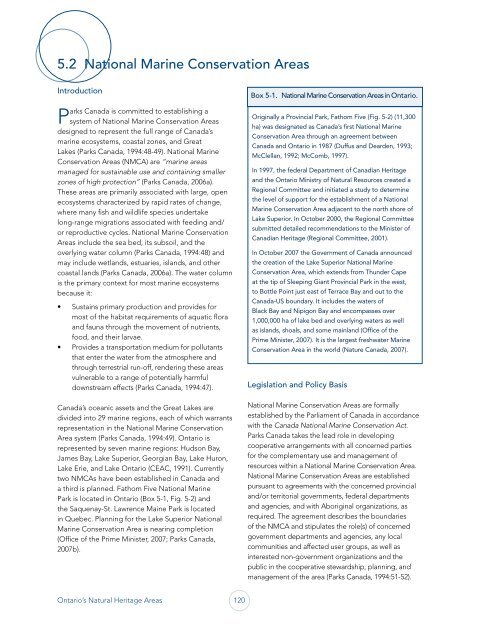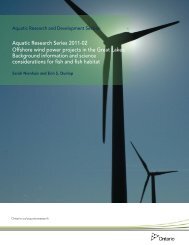Ontario's Natural Heritage Areas - Ministry of Natural Resources
Ontario's Natural Heritage Areas - Ministry of Natural Resources
Ontario's Natural Heritage Areas - Ministry of Natural Resources
You also want an ePaper? Increase the reach of your titles
YUMPU automatically turns print PDFs into web optimized ePapers that Google loves.
5.2 National Marine Conservation <strong>Areas</strong><br />
Introduction<br />
Parks Canada is committed to establishing a<br />
system <strong>of</strong> National Marine Conservation <strong>Areas</strong><br />
designed to represent the full range <strong>of</strong> Canada’s<br />
marine ecosystems, coastal zones, and Great<br />
Lakes (Parks Canada, 1994:48-49). National Marine<br />
Conservation <strong>Areas</strong> (NMCA) are “marine areas<br />
managed for sustainable use and containing smaller<br />
zones <strong>of</strong> high protection” (Parks Canada, 2006a).<br />
These areas are primarily associated with large, open<br />
ecosystems characterized by rapid rates <strong>of</strong> change,<br />
where many fish and wildlife species undertake<br />
long-range migrations associated with feeding and/<br />
or reproductive cycles. National Marine Conservation<br />
<strong>Areas</strong> include the sea bed, its subsoil, and the<br />
overlying water column (Parks Canada, 1994:48) and<br />
may include wetlands, estuaries, islands, and other<br />
coastal lands (Parks Canada, 2006a). The water column<br />
is the primary context for most marine ecosystems<br />
because it:<br />
• Sustains primary production and provides for<br />
most <strong>of</strong> the habitat requirements <strong>of</strong> aquatic flora<br />
and fauna through the movement <strong>of</strong> nutrients,<br />
food, and their larvae.<br />
• Provides a transportation medium for pollutants<br />
that enter the water from the atmosphere and<br />
through terrestrial run-<strong>of</strong>f, rendering these areas<br />
vulnerable to a range <strong>of</strong> potentially harmful<br />
downstream effects (Parks Canada, 1994:47).<br />
Canada’s oceanic assets and the Great Lakes are<br />
divided into 29 marine regions, each <strong>of</strong> which warrants<br />
representation in the National Marine Conservation<br />
Area system (Parks Canada, 1994:49). Ontario is<br />
represented by seven marine regions: Hudson Bay,<br />
James Bay, Lake Superior, Georgian Bay, Lake Huron,<br />
Lake Erie, and Lake Ontario (CEAC, 1991). Currently<br />
two NMCAs have been established in Canada and<br />
a third is planned. Fathom Five National Marine<br />
Park is located in Ontario (Box 5-1, Fig. 5-2) and<br />
the Saquenay-St. Lawrence Maine Park is located<br />
in Quebec. Planning for the Lake Superior National<br />
Marine Conservation Area is nearing completion<br />
(Office <strong>of</strong> the Prime Minister, 2007; Parks Canada,<br />
2007b).<br />
Ontario’s <strong>Natural</strong> <strong>Heritage</strong> <strong>Areas</strong> 120<br />
Box 5-1. National Marine Conservation <strong>Areas</strong> in Ontario.<br />
Originally a Provincial Park, Fathom Five (Fig. 5-2) (11,300<br />
ha) was designated as Canada’s first National Marine<br />
Conservation Area through an agreement between<br />
Canada and Ontario in 1987 (Duffus and Dearden, 1993;<br />
McClellan, 1992; McComb, 1997).<br />
In 1997, the federal Department <strong>of</strong> Canadian <strong>Heritage</strong><br />
and the Ontario <strong>Ministry</strong> <strong>of</strong> <strong>Natural</strong> <strong>Resources</strong> created a<br />
Regional Committee and initiated a study to determine<br />
the level <strong>of</strong> support for the establishment <strong>of</strong> a National<br />
Marine Conservation Area adjacent to the north shore <strong>of</strong><br />
Lake Superior. In October 2000, the Regional Committee<br />
submitted detailed recommendations to the Minister <strong>of</strong><br />
Canadian <strong>Heritage</strong> (Regional Committee, 2001).<br />
In October 2007 the Government <strong>of</strong> Canada announced<br />
the creation <strong>of</strong> the Lake Superior National Marine<br />
Conservation Area, which extends from Thunder Cape<br />
at the tip <strong>of</strong> Sleeping Giant Provincial Park in the west,<br />
to Bottle Point just east <strong>of</strong> Terrace Bay and out to the<br />
Canada-US boundary. It includes the waters <strong>of</strong><br />
Black Bay and Nipigon Bay and encompasses over<br />
1,000,000 ha <strong>of</strong> lake bed and overlying waters as well<br />
as islands, shoals, and some mainland (Office <strong>of</strong> the<br />
Prime Minister, 2007). It is the largest freshwater Marine<br />
Conservation Area in the world (Nature Canada, 2007).<br />
Legislation and Policy Basis<br />
National Marine Conservation <strong>Areas</strong> are formally<br />
established by the Parliament <strong>of</strong> Canada in accordance<br />
with the Canada National Marine Conservation Act.<br />
Parks Canada takes the lead role in developing<br />
cooperative arrangements with all concerned parties<br />
for the complementary use and management <strong>of</strong><br />
resources within a National Marine Conservation Area.<br />
National Marine Conservation <strong>Areas</strong> are established<br />
pursuant to agreements with the concerned provincial<br />
and/or territorial governments, federal departments<br />
and agencies, and with Aboriginal organizations, as<br />
required. The agreement describes the boundaries<br />
<strong>of</strong> the NMCA and stipulates the role(s) <strong>of</strong> concerned<br />
government departments and agencies, any local<br />
communities and affected user groups, as well as<br />
interested non-government organizations and the<br />
public in the cooperative stewardship, planning, and<br />
management <strong>of</strong> the area (Parks Canada, 1994:51-52).

















